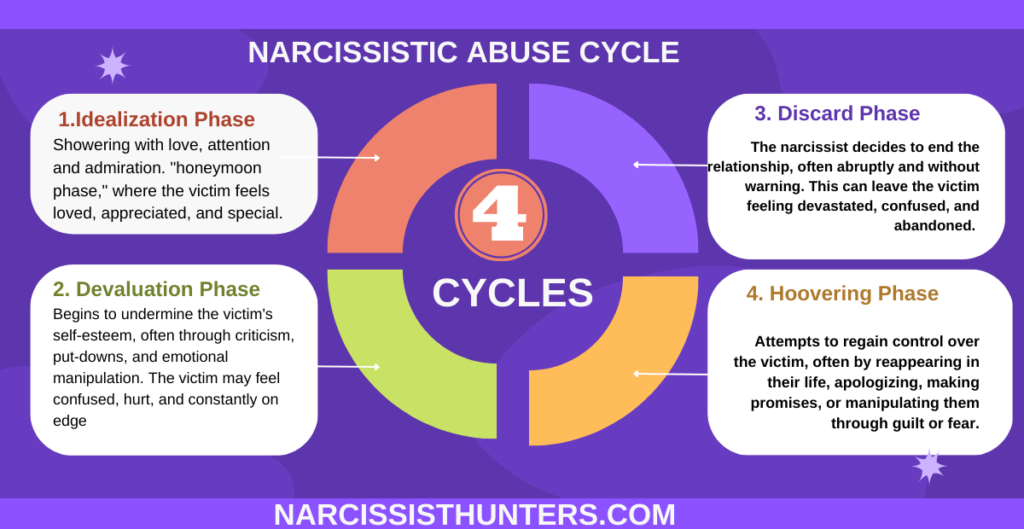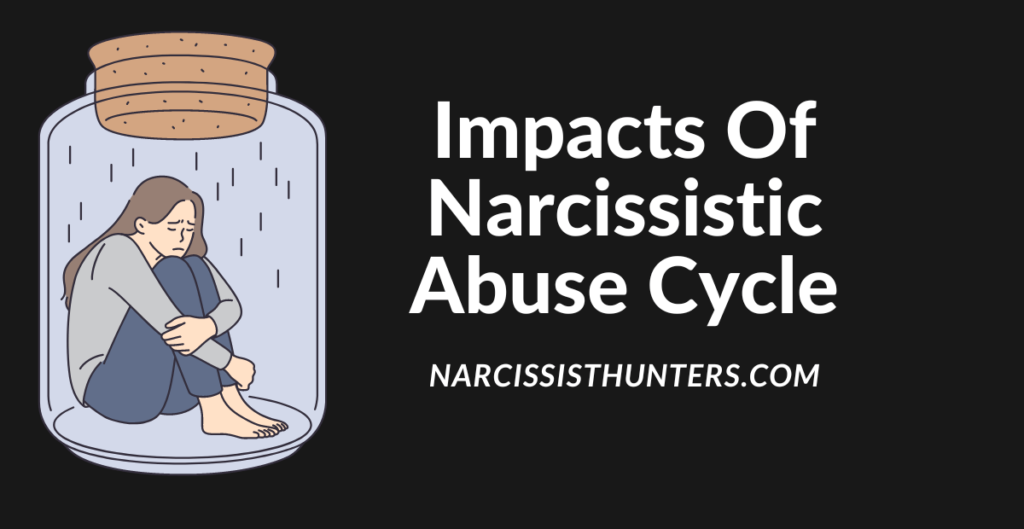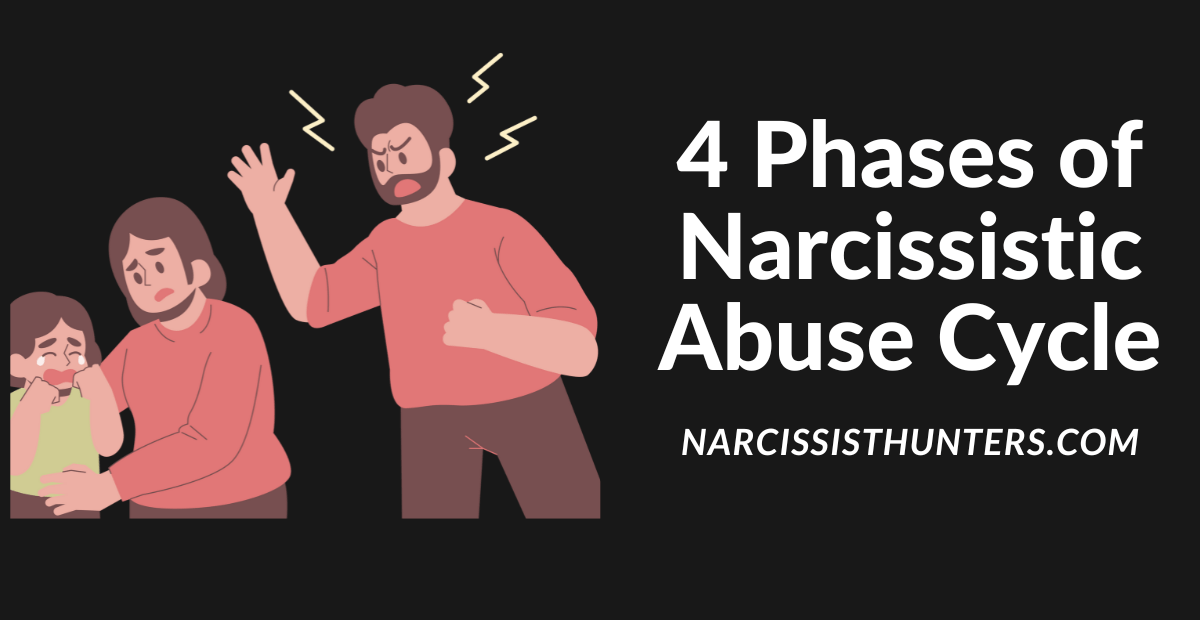Have you ever been in a relationship where you were showered with love and attention, only to be devalued and discarded later on? If so, you may have been a victim of narcissistic abuse. Narcissistic abuse is a pattern of behavior that can have serious and long-lasting effects on a person’s mental health and well-being.Breaking the cycle of narcissistic abuse is crucial for victims to regain their sense of self-worth and move towards a healthier future.
However, it can be a challenging and complex process that requires a deep understanding of the different phases of the narcissistic abuse cycle and practical strategies for healing and moving forward.
In this blog post, I will provide a comprehensive guide to the cycle of narcissistic abuse, including the different phases involved and the impact it can have on victims. I will also offer practical advice on how to break the cycle of abuse, seek help, and move towards a happier and healthier life.
What is Cycle Of Narcissistic Abuse?

The cycle of narcissistic abuse is a pattern of behavior that narcissists use to control and manipulate their victims. It typically consists of four phases: idealization, devaluation, discard, and hoovering. While not every narcissist follows this exact pattern, the cycle of narcissistic abuse is a common pattern that many victims experience.
Here is a table summarizing the cycle of narcissistic abuse:
| Stage | Description |
|---|---|
| Idealization | The narcissist idealizes the victim, showering them with love, attention, and admiration. This stage can be described as the “honeymoon phase,” where the victim feels loved, appreciated, and special. |
| Devaluation | The narcissist begins to undermine the victim’s self-esteem, often through criticism, put-downs, and emotional manipulation. The victim may feel confused, hurt, and constantly on edge, as the narcissist’s behavior becomes more erratic and unpredictable. |
| Discard | The narcissist decides to end the relationship, often abruptly and without warning. This can leave the victim feeling devastated, confused, and abandoned. The narcissist may move on quickly to a new partner, leaving the victim feeling replaced and discarded. |
| Hoovering | The narcissist attempts to regain control over the victim, often by reappearing in their life, apologizing, making promises, or manipulating them through guilt or fear. This can be a confusing and dangerous stage, as the victim may be tempted to re-engage with the narcissist, only to be hurt again. It is important for the victim to set clear boundaries and seek support during this phase. |
Phases Of Narcissistic Abuse Cycle
Here are 4 phases of cycle of narcissistic abuse:
1.The Idealization Phase
The idealization phase is the beginning of the cycle of narcissistic abuse. During this phase, the narcissist showers their victim with attention, affection, and love, making them feel valued and special. They may appear charming, charismatic, and attentive, making the victim believe that they have found their perfect partner or friend. This phase is also known as love-bombing.
However, the idealization phase is a trap that the narcissist uses to manipulate their victim. They are not genuinely interested in the victim’s well-being or happiness, but rather in what they can get out of the relationship. The narcissist uses their victim’s vulnerabilities and insecurities to build a bond and gain control.
Red flags to watch out for during the idealization phase include:
- Intense and rapid expressions of love or affection
- Constant flattery and compliments
- Grand gestures of love and generosity
- A willingness to overlook or ignore flaws or differences in the relationship
- Isolation from family and friends
- An insistence on constant communication or attention
- An overly eager desire to please the victim
2. The Devaluation Phase
The devaluation phase is the second phase of the cycle of narcissistic abuse. During this phase, the narcissist begins to mistreat their victim, often without warning or explanation. They may suddenly become distant, critical, or dismissive of the victim’s needs and feelings. They may start to blame the victim for their problems or accuse them of being ungrateful or selfish.
The devaluation phase can be particularly damaging to the victim’s self-esteem and mental health. They may feel confused, hurt, and betrayed by the sudden change in the narcissist’s behavior. They may also start to doubt their own worth and question whether they did something to cause the abuse.
Some signs of the devaluation phase include:
- Criticism and belittling of the victim’s opinions or feelings
- Ignoring or dismissing the victim’s needs and desires
- Isolating the victim from friends and family
- Blaming the victim for problems in the relationship
- Gaslighting or distorting reality to make the victim doubt their memory or perception
- Flipping between love and hate towards the victim
3. The Discard Phase
The discard phase is the third phase of the cycle of narcissistic abuse. During this phase, the narcissist ends the relationship abruptly and without warning. They may disappear without explanation, refuse to communicate with the victim, or simply move on to a new target.
Here are some signs that you may be entering the discard phase of narcissistic abuse:
A.Your partner is suddenly cold and distant
A narcissist will often distance themselves emotionally before they physically leave. They may stop showing affection, stop communicating, or start criticizing you more often.
B. Your partner starts making excuses
A narcissist may make excuses for why they can’t spend time with you, such as being busy with work or having other commitments.
C.Your partner becomes more critical
During the discard phase, a narcissist may start criticizing you more often or making you feel like you’re not good enough. This is a way to justify their decision to end the relationship.
D. Your partner starts looking for someone else
A narcissist may start looking for a new source of narcissistic supply before they end the relationship with you. This can involve flirting with other people or even starting a new relationship before the old one has ended.
E. Your partner ends the relationship abruptly
Sometimes, a narcissist will end the relationship abruptly without any warning. This can leave the victim feeling confused, hurt, and abandoned.
The psychological impact of discard on the victim can be devastating. They may feel abandoned, rejected, and confused by the sudden end of the relationship. They may also struggle with feelings of grief, anger, and betrayal. The discard phase can also trigger feelings of worthlessness and low self-esteem, as the victim may believe that they were
4. The Hoovering Phase
After the discard phase, the narcissist may begin the hoovering phase. During this phase, the narcissist will attempt to regain control over their victim.
Here are some signs that you may be experiencing the hoovering phase:
A. Unexpected contact
The narcissist may reach out to you unexpectedly after a period of no contact. This could come in the form of a phone call, text message, or email.
B. Love bombing
The narcissist may shower you with attention, compliments, and promises of change. They may try to win you back with grand gestures, gifts, or extravagant displays of affection. Read more here about love bombing and what narcissists do during this.
C. Apologies
The narcissist may apologize for their past behavior and express remorse for how they treated you. However, it’s important to recognize that these apologies are often insincere and are only being made to manipulate you.
D. Guilt trips
The narcissist may use guilt or shame to try to get you to come back to them. They may try to make you feel responsible for their well-being or use tactics like gaslighting to make you doubt your own perceptions.
E. Blame-shifting
The narcissist may try to shift the blame for the relationship problems onto you. They may deny any responsibility for their actions and make you feel like you are the one who needs to change.
F. Pressure
The narcissist may try to pressure you into getting back together with them. They may threaten you or use emotional blackmail to get you to comply with their wishes.
Impacts of Narcissistic Abuse Cycle

The cycle of narcissistic abuse can have profound and long-lasting impacts on the victim’s mental, emotional, and physical well-being. Here are some common effects of the cycle of narcissistic abuse:
- Low self-esteem: The constant criticism, put-downs, and emotional manipulation of the devaluation stage can erode the victim’s self-esteem, leaving them feeling worthless, unlovable, and incapable of making their own decisions.
- Anxiety and depression: The unpredictable and volatile behavior of the narcissist can leave the victim feeling anxious, depressed, and constantly on edge. This can lead to a range of mental health issues, including panic attacks, phobias, and PTSD.
- Isolation: The narcissist may isolate the victim from friends, family, and support systems, leaving them feeling alone and helpless. This can make it difficult for the victim to seek help or escape the abusive situation.
- Physical health problems: The stress and trauma of narcissistic abuse can lead to physical health problems, including chronic pain, digestive issues, and sleep disorders.
- Addiction: Some victims may turn to substance abuse or other addictive behaviors as a way to cope with the trauma of narcissistic abuse.
- Trust issues: The betrayal and manipulation of the narcissist can make it difficult for the victim to trust others and form healthy relationships in the future.
- Financial problems: The narcissist may control the victim’s finances, leaving them financially dependent and vulnerable to economic abuse.
How Long Do Narcissistic Abuse Cycles Last?
The length of a narcissistic cycle can vary depending on the specific situation and individuals involved. In some cases, the idealization phase can last for months or even years before shifting to the devaluation phase.
The devaluation phase can also vary in length, with some victims enduring mistreatment for a short period of time, while others may suffer for years. The discard phase can also vary in length, with some narcissists suddenly ending the relationship, while others may slowly withdraw and distance themselves over time.
It’s important to note that not all narcissistic cycles follow a predictable pattern or timeline. Some narcissistic abusers may cycle through phases more rapidly, while others may get stuck in one phase for an extended period of time.
Additionally, the length of the cycle may depend on the victim’s response to the abuse, as well as external factors such as the abuser’s other relationships, work or financial stress, and other life events.
Why do Narcissists follow idealize-devalue-discard cycle?
Narcissists follow the idealize-devalue-discard cycle for a variety of reasons, many of which are rooted in their own psychological makeup and insecurities.
During the idealization phase, the narcissist uses tactics such as love bombing, gifts, and flattery to gain the victim’s trust and admiration. This phase allows the narcissist to feel a sense of power and control over the victim while also satisfying their own need for attention and validation.
As the relationship progresses, the narcissist may become bored, disillusioned, or threatened by the victim’s independence or accomplishments. This can lead to the devaluation phase, where the narcissist uses tactics such as criticism, belittling, and emotional abuse to regain a sense of power and control over the victim.
Ultimately, the narcissist may end the relationship during the discard phase, either because they feel they have “won” the power struggle, or because they have found a new source of attention and validation.
Breaking the Cycle of Narcissistic Abuse
How to break the cycle of narcissistic abuse? Here is a guide to break narcissistic abuse cycle”
1.Identify your core values and beliefs
One of the key ways to break the cycle of narcissistic abuse is to identify your core values and beliefs. These are the things that are most important to you in life and serve as a guide for your actions and decisions.
When you have a clear understanding of your values and beliefs, it becomes easier to recognize when the narcissist is attempting to manipulate or control you. Take some time to reflect on what is most important to you and write down your core values.
2. Set clear boundaries
Setting clear boundaries is essential when breaking the cycle of narcissistic abuse. Boundaries are the lines that you draw around yourself to protect your physical, emotional, and mental health.
Examples of boundaries include limiting contact with the narcissist, refusing to engage in arguments or conversations that feel toxic, and setting limits on how much time and energy you are willing to devote to the relationship. Remember that boundaries are not about punishing the narcissist, but rather about protecting yourself.
Download setting boundaries worksheet free.
3. Practice self-compassion
Surviving narcissistic abuse can be a traumatic experience that leaves you feeling depleted and disconnected from yourself. Practicing self-compassion is a way to reconnect with your inner self and show yourself kindness and understanding.
This may involve activities like journaling, meditation, or therapy. It is important to remember that healing from narcissistic abuse is a process that takes time and effort.
4. Build a support system
Having a strong support system is essential when breaking the cycle of narcissistic abuse. This may involve reaching out to friends or family members who can offer emotional support and validation.
It may also involve seeking out a therapist or joining a support group for survivors of narcissistic abuse. Having people in your life who understand what you are going through and can offer support and encouragement can make a big difference in your healing journey.
5. Focus on your personal growth
Breaking the cycle of narcissistic abuse is an opportunity to focus on your personal growth and development. This may involve setting goals for yourself, pursuing hobbies and interests that bring you joy, and working on developing new skills.
When you focus on your personal growth, you are investing in yourself and creating a brighter future for yourself.
Last words
In conclusion, understanding the cycle of narcissistic abuse is essential for recognizing the signs of abuse and breaking free from its damaging effects. By identifying the idealization, devaluation, discard, and hoovering phases of the cycle, victims can take steps to protect themselves and seek help from trained professionals and support groups.
Breaking the cycle of narcissistic abuse is not easy, but it is possible. It takes time, effort, and commitment to healing, but with the right support, victims can regain control of their lives and move forward with strength and resilience.
Remember, if you or someone you know is experiencing narcissistic abuse, you are not alone, and help is available. Prioritize your well-being, seek help, and know that healing is possible.
